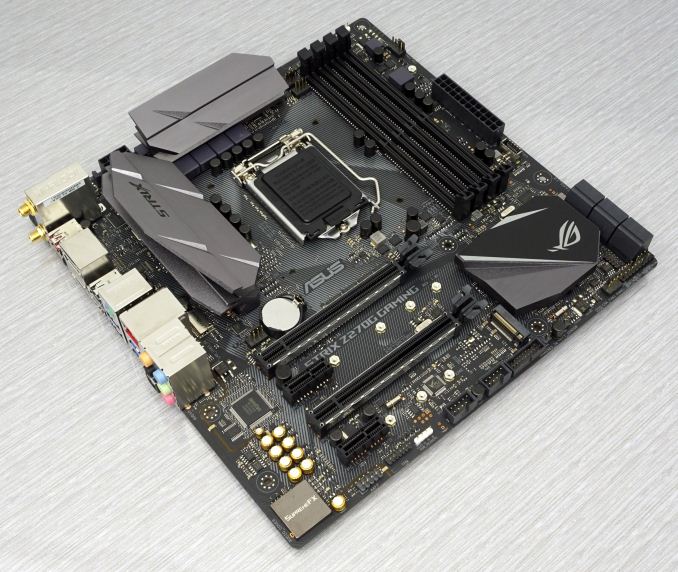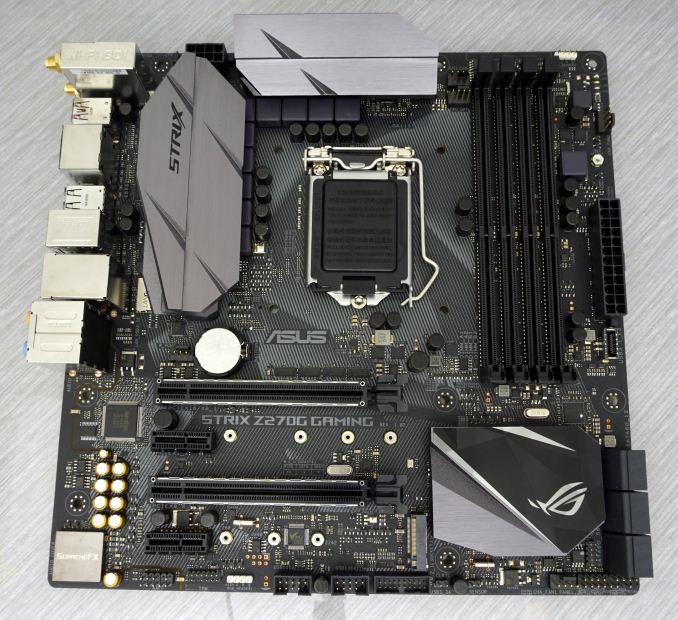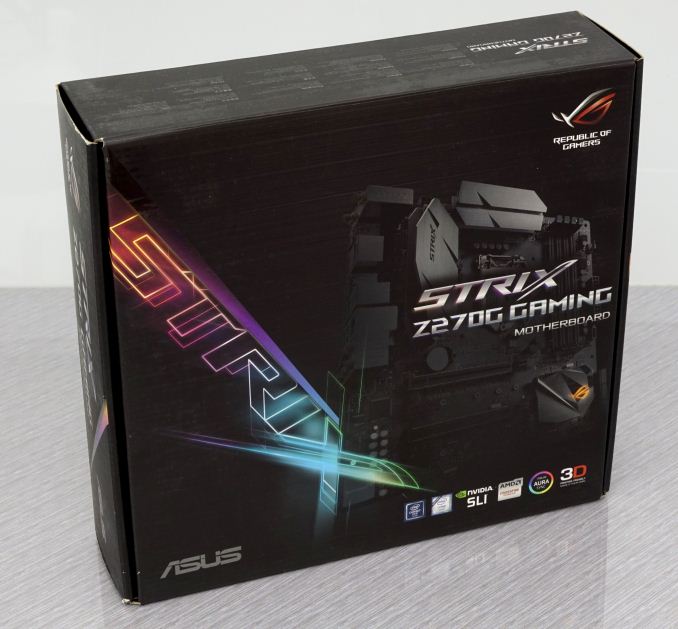The Asus ROG Strix Z270G Gaming Motherboard Review
by E. Fylladitakis on October 3, 2017 8:15 AM EST
Micro ATX motherboards mark the spot between the limiting Mini ITX motherboards that are limited to a single expansion slot and the classic ATX motherboards that often offer more than what the user requires. Many users need more than a single PCIe slot but not nearly as many as seven. In this review, we are having a look at the Asus ROG Strix Z270G Gaming, a Micro ATX motherboard based on the Intel Z270 chipset.
We have looked at both Mini ITX and ATX motherboards based on Intel’s Z270 in the past few months, but not yet a Micro ATX motherboard. Although their market share is relatively low, Micro ATX systems are a viable compromise between the very compact but limiting Mini ITX factor and a full-size ATX motherboard. The Asus ROG Strix Z270G Gaming is specifically designed to be the basis of a powerful SLI/Crossfire gaming system that will be a little bit more compact than that of a full-size ATX motherboard.
Asus ROG Strix Z270G Gaming Overview
A quick look at the Asus ROG Strix Z270G Gaming reveals that the Micro ATX motherboard is loaded with features that are directly comparable in quality and number to those of any ATX motherboard around its price range. As it is 59 mm shorter than an ATX motherboard, the Asus ROG Strix Z270G Gaming has three fewer expansion slots. The configuration that Asus went with is two full-length PCIe ×16 slots (×8/×8 in SLI/Crossfire) and two short PCIe ×1 slots. There are two PCIe ×4 M.2 slots and six SATA connectors, which ought to be enough for the storage requirements of any gaming or home entertainment system. There are no native U.2 connectors, but U.2 drives can be connected to the M.2 slots by using appropriate adapters. Asus does not add any SATA Express connectors on most of their gaming range motherboards and the ROG Strix Z270G Gaming is, expectedly, no exception to that rule.
The controllers of the ROG Strix Z270G Gaming motherboard are interesting, yet nothing out of the ordinary for a motherboard of this class. For audio, Asus is particularly proud about their “Supreme FX” audio system that implements the Realtek ALC S1220A (aka ALC1220A) audio CODEC and is placing a lot of their marketing efforts on it. The single wired Gigabit LAN chipset is the very popular Intel I219-V, with Asus expressively advertising the implementation of their surge protection feature called “LANGuard”. Asus has also added a WiFi/Bluetooth module from Qualcomm (Atheros QCNFA364A). Finally, there are two USB 3.1 controllers from ASMedia, one for the rear USB 3.1 Gen 2 ports (one Type-A and one Type-C) and one for the internal USB 3.1 Gen 2 header. At this point, we should also mention that the ROG Strix Z270G Gaming is the first Z270 motherboard that we have tested that has an internal USB 3.1 Gen 2 header.
From our testing, the Asus ROG Strix Z270G Gaming performs well under its default settings, with the spotlight being its extraordinary audio performance. In terms of raw speed and/or stability, it does not differentiate from any other typical Z270 motherboard, except when compared to models that do not have multi-core turbo enabled by default or are practicing overclocking under their default setup. We also acquired very good overclocking results that will certainly please more advanced users who are planning on building a very powerful cost-effective gaming system.
| Motherboard Comparison | ||
| Asus ROG STRIX Z270G GAMING | ||
| Socket | LGA1151 | LGA1151 |
| MSRP at Review | $349 | $140 |
| DRAM | 4 x DDR4 | 4 x DDR4 |
| PCIe Layout | ×8/×8 | x8/x8 |
| BIOS Version Tested | 0604 | 2.00 |
| MCT Enabled Automatically? | Yes | Yes |
| USB 3.1 (10 Gbps) | 2 × ASMedia ASM2142 | None |
| M.2 Slots | 2 x PCIe 3.0 x4 | 2 x PCIe 3.0 x4 |
| U.2 Ports | No | No |
| Network Controller | 1 x Intel I219-V 1 x Qualcomm QCNFA364A |
1 x Intel I219-V |
| Audio Controller | Realtek ALC1220A | Realtek ALC892 |
| HDMI 2.0 | No | No |
Other AnandTech Reviews for Intel’s 7th Generation CPUs and 200-Series Motherboards
($110) The ECS Z270H4-I Durathon 2 Review
($140) The ASRock Z270 Killer SLI Review
($140) The MSI Z270 SLI PLUS Review
($159) The ASRock Z270 Gaming-ITX/AC Review
($170) The Asus Prime Z270-A
($170) The GIGABYTE Z270X-Ultra Gaming
($349) The ASRock Z270 Supercarrier Motherboard Review
The Intel Core i7-7700K (91W) Review
The Intel Core i5-7600K (91W) Review
The Intel Core i3-7350K (60W) Review
CPU Buyer's Guide
In comparison to the older Z170 boards, the Z270 boards on the base specifications are hardly any different. The Z270 ones have four extra PCIe lanes configurable on the chipset, potentially new audio and new networking controllers, and Intel Optane Technology Support. Although four extra PCIe lanes do sound like a huge difference, it is an important upgrade for the implementation of native M.2 slots (on Z170-based motherboards, this usually meant disabling some other device/port on the motherboard). Also, note that Intel Optane drives should still function on other chipsets as drives; the Z270 only allows them to enable their “smart caching” technology.
The Intel Optane Memory (SSD) Preview: 32GB of Kaby Lake Caching
Individual motherboard manufacturers will be sprinkling on new features onto their Z270 products to aid the transition and provide other tangible benefits over the old platform. To read specifically about the Z170 chip/platform and the specifications therein, our deep dive into what it is can be found at this link.
A Small Note on USB Naming
One thing that we should note is that the advent of the Z270 chipset brought a change on the naming of the USB ports. What we knew as USB 3.0 ports are now being dubbed as “USB 3.1 Gen 1” and the 10Gbps ports are now called “USB 3.1 Gen 2”. We first encountered this change while reviewing the MSI Z270 SLI Plus a few months ago but it seems that most of the manufacturers are following suit, rewriting their websites and reprinting their manuals. Users need to be extra careful when very high bandwidth connectors are essential.












26 Comments
View All Comments
Sarah Terra - Wednesday, October 4, 2017 - link
This website is a prime example of what happens when you hire millennial's to your company, slow , shoddy, confounding, and quite frankly idiotic work ethic.What's happening here is AT is on a super tight budget, trying to squeeze lemons from limes, and the squeezer's don't really "feel they deserve being worked so hard"
guidryp - Tuesday, October 3, 2017 - link
$350 for a MB?This is what will likely drive me to AMD when I build my first PC in years. I can overclock AMD on any of a wide selection of sub $100 MBs.
MajGenRelativity - Tuesday, October 3, 2017 - link
Higher-end motherboards have a selection of features that are not present on lower-end motherboards. Like in other markets, price variation exists because of feature differentiation.Disclaimer: I own a $550 motherboard.
DanNeely - Tuesday, October 3, 2017 - link
Halo products are always the most expensive. You can find reasonably priced parts for both companies mainstream sockets.New Z270 and X370 boards both start at slightly over $100 on Newegg; down to $50ish for the entry level chipset in each family.
Big socket boards are more expensive. Intels X299 starts at just $210, X399 at $340; a socket 2/4x as large as mainstream doesn't come free. All of the extra stuff they include requires a more complex mobo to implement; so while Threadripper boards might narrow the price gap a bit vs Intels LGA2066 boards as they're out longer they'll never get to be as cheap because there's so much more they need to do. (Unless you want a cheap TR board that only has 32 PCIe lanes enabled or something like that.)
jardows2 - Tuesday, October 3, 2017 - link
Plenty of Z270 boards in the $100 - $150 price range. There are AM4 boards in the $250 - $350 price range available as well, if you want to spend the money.Another question to ask, do you really want to overclock on that sub $100 board? Just because you can doesn't mean you should, depending on the quality of components available. And just for arguments sake, make sure you are looking at AM4 boards, not the near ancient AM3+ boards.
StrangerGuy - Wednesday, October 4, 2017 - link
So with the current crop of Intel/AMD CPUs, spend $300+ on a mobo for like a 10% OC while turning my PC into a space heater = lol no thanks, I got way better things to spend money on.And nobody really gave a crap about VRM quality 10 years ago when CPU OCing was actually worth it from a value perspective, unlike today where everyone is trying to be a youtube OC superstar trying to outdo each other in their ego.
TEAMSWITCHER - Tuesday, October 3, 2017 - link
That price is an error. If you click the price to activate the link, you go to the WRONG motherboard.DanNeely - Tuesday, October 3, 2017 - link
Good catch there. This is the right one, and only $189.https://www.newegg.com/Product/Product.aspx?Item=N...
smilingcrow - Tuesday, October 3, 2017 - link
You have little sense of context.wolfemane - Tuesday, October 3, 2017 - link
Wow, the day has finally come where Asus is trailing Asrock. I’ve always been a big fan of asrock boards. And in my opinion they have better customer and technical support.Asus support is the worst I’ve ever dealt with.
With that all said, I wonder how z370 will hold up against Z270. Other than core count on the CPUs not much has changed for this chipset. Am I correct in this?